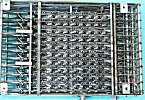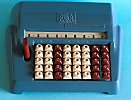This mechanical adder was introduced in 1887. There were a set of digit keys 1-9 for each position (zeros weren't entered) and a lever to clear the result. Numbers were added as each digit key was pressed leaving no room for error. Results were accumulated in the 11 windows below the keyboard. Unlike the slide adders above, this machine did fully automatic carries. For example if 99999999 was displayed and the 1 key was pressed, in well under a second the machine displayed 100000000. The machine suppressed leading zeroes. On each digit wheel, the zero was actually a window into an inner wheel. A shutter wheel could rotate to cover the zero below. Subtraction on the Comptometer was via complementary digits. These digits were printed smaller than the additive digits on each key.
As with most adding machines, subtraction via complementary digits was a little tricky. The user needed to mentally subtract one from the number to be added and since there were no complementary 9 digits, 9s were simply skipped. Also, an extra 1 appeared to the left of the real answer which could be ignored or shifted further to the left by pressing 9 keys.
For example: to do 444-160, the user pressed 444 using the large digits and then entered 15[empty space] which left 1284 in the display. The user ignored the 1 leaving the correct answer of 284. (The empty space was because 160-1 = 159 and there are no complementary 9 digits.)
The Comptometer was on the market for over 40 years and in that time a number of improvements were made. One improvement was fail-safe keys which locked the machine if the operator failed to press them completely. (Comptometer keys had a long travel, because the keys, rather than a crank, powered the works.) This prevented a partial press from generating an error as it could on an earlier model. Once, the operator realized the machine was locked, the digit could be fully pressed and the machine could be unlocked with the lever on the left.
Another improvement allowed an unlimited number of keys to be pressed at once. (One per column.) This allowed faster adding and made multiplication of some numbers possible. For example to multiply 1234 by 125, the user would place fingers on 1, 2, 3, and 4 and press 5 times (times 5). Then the user would shift the fingers one column to the left and press 2 times (times 20) and then shift one column to the left and press once (times 100). Of course this only worked for small numbers of digits - generally four when using both hands and allowing the mind to wander during these operations tended to result in huge errors. (Not only might the operator miscount a digit, but might add or drop digits and there was no way to tell.) Nonetheless, the ability to do tens carries originated simultaneously from multiple columns was an impressive advance. (For reasonably small numbers, this machine might be considered a full four function calculator.)
The Comptometer used the rocking segment mechanism, but pressing the keys both set the mechanism's stopping point and rocked it.

|
Picture of Comptometer. (A late model with the improvements mentioned above.) |

|
Picture of Comptometer Interior. What may appear to be a pattern is really many tiny parts in this complex machine. See the next picture for a close up on a few parts. |

|
Close up on a tiny section in the center of the above view. (These two pictures only show a portion of the interior.) |

|
End view of the mechanism. The keys are visible at the top. |
This Burroughs direct adding machine was very similar to the Comptometer. (So similar that Burroughs was apparently sued over it.) It provided the essentially the same functions and feel but with a slightly smaller foot print.

|
Picture of the Burroughs Direct Adder. |
This Speedee adder had only the numbers 1-5 in each row. This required less hand movement but required multiple key presses to enter anything higher than 5.

|
Picture of the Speedee Adder. |
![]() Back to early models contents
Back to early models contents
![]() Go on to the four function machines
Go on to the four function machines
![]() Back to the printing models
Back to the printing models